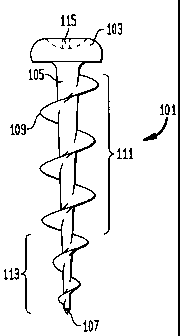Some of the information on this Web page has been provided by external sources. The Government of Canada is not responsible for the accuracy, reliability or currency of the information supplied by external sources. Users wishing to rely upon this information should consult directly with the source of the information. Content provided by external sources is not subject to official languages, privacy and accessibility requirements.
Any discrepancies in the text and image of the Claims and Abstract are due to differing posting times. Text of the Claims and Abstract are posted:
| (12) Patent: | (11) CA 2352026 |
|---|---|
| (54) English Title: | AUGER-LIKE DRYWALL SCREW |
| (54) French Title: | VIS EN FORME DE TARIERE POUR CLOISONS SECHES |
| Status: | Expired and beyond the Period of Reversal |
| (51) International Patent Classification (IPC): |
|
|---|---|
| (72) Inventors : |
|
| (73) Owners : |
|
| (71) Applicants : |
|
| (74) Agent: | SMART & BIGGAR LP |
| (74) Associate agent: | |
| (45) Issued: | 2008-11-18 |
| (22) Filed Date: | 2001-07-03 |
| (41) Open to Public Inspection: | 2002-02-08 |
| Examination requested: | 2004-06-23 |
| Availability of licence: | N/A |
| Dedicated to the Public: | N/A |
| (25) Language of filing: | English |
| Patent Cooperation Treaty (PCT): | No |
|---|
| (30) Application Priority Data: | ||||||
|---|---|---|---|---|---|---|
|
The present invention relates to a screw having a head, shank, and a helical thread. The head is optionally adapted to be engaged by a driving tool. The shank is attached to the head and has a free distal end, and is tapered to decrease in diameter from the head to the distal end. The helical thread has the geometry of an auger with a pitch diameter of at least twice the largest minimum diameter of the shank.
La présente invention porte sur une vis dotée d'une tête, d'une tige et d'un filetage hélicoïdal. La tête, en option, est adaptée pour entrer en contact avec un outil d'entraînement. La tige est fixée à la tête et comprend une extrémité distale libre, et elle est effilée pour réduire le diamètre à partir de la tête à l'extrémité distale. Le filetage hélicoïdal a la géométrie d'une tarière avec un diamètre de fonctionnement d'au moins deux fois le diamètre minimal le plus large de la tige.
Note: Claims are shown in the official language in which they were submitted.
Note: Descriptions are shown in the official language in which they were submitted.

2024-08-01:As part of the Next Generation Patents (NGP) transition, the Canadian Patents Database (CPD) now contains a more detailed Event History, which replicates the Event Log of our new back-office solution.
Please note that "Inactive:" events refers to events no longer in use in our new back-office solution.
For a clearer understanding of the status of the application/patent presented on this page, the site Disclaimer , as well as the definitions for Patent , Event History , Maintenance Fee and Payment History should be consulted.
| Description | Date |
|---|---|
| Time Limit for Reversal Expired | 2016-07-04 |
| Letter Sent | 2015-07-03 |
| Inactive: Late MF processed | 2013-06-17 |
| Letter Sent | 2012-07-03 |
| Inactive: Late MF processed | 2011-10-06 |
| Letter Sent | 2011-07-04 |
| Inactive: Late MF processed | 2011-02-04 |
| Letter Sent | 2010-07-05 |
| Grant by Issuance | 2008-11-18 |
| Inactive: Cover page published | 2008-11-17 |
| Pre-grant | 2008-09-02 |
| Inactive: Final fee received | 2008-09-02 |
| Notice of Allowance is Issued | 2008-03-18 |
| Letter Sent | 2008-03-18 |
| Notice of Allowance is Issued | 2008-03-18 |
| Inactive: Approved for allowance (AFA) | 2007-11-30 |
| Amendment Received - Voluntary Amendment | 2007-08-02 |
| Inactive: S.30(2) Rules - Examiner requisition | 2007-02-05 |
| Inactive: IPC from MCD | 2006-03-12 |
| Inactive: IPC from MCD | 2006-03-12 |
| Letter Sent | 2004-07-06 |
| Request for Examination Received | 2004-06-23 |
| Request for Examination Requirements Determined Compliant | 2004-06-23 |
| All Requirements for Examination Determined Compliant | 2004-06-23 |
| Letter Sent | 2002-08-21 |
| Inactive: Correspondence - Transfer | 2002-07-25 |
| Inactive: Single transfer | 2002-07-02 |
| Application Published (Open to Public Inspection) | 2002-02-08 |
| Inactive: Cover page published | 2002-02-07 |
| Inactive: First IPC assigned | 2001-08-23 |
| Inactive: Courtesy letter - Evidence | 2001-07-31 |
| Inactive: Filing certificate - No RFE (English) | 2001-07-27 |
| Filing Requirements Determined Compliant | 2001-07-27 |
| Application Received - Regular National | 2001-07-27 |
There is no abandonment history.
The last payment was received on 2008-06-04
Note : If the full payment has not been received on or before the date indicated, a further fee may be required which may be one of the following
Please refer to the CIPO Patent Fees web page to see all current fee amounts.
Note: Records showing the ownership history in alphabetical order.
| Current Owners on Record |
|---|
| POWERS PRODUCTS III, L.L.C. |
| Past Owners on Record |
|---|
| PAUL GAUDRON |